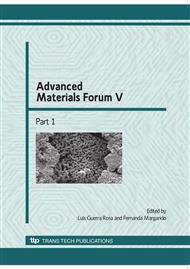p.3
p.9
p.15
p.22
p.26
p.31
p.36
Electrochemical Formation and Corrosion Properties of Porous TiOx Biomaterials
Abstract:
Formation of porous TiOx layers on Ti during electrochemical etching in H3PO4, CH3COOH electrolytes modified by HF and NH4F was described. The anodization resulted in porous TiOx formation, useful in tissue growth and bone bonding. The pore dimensions increased due to the increase of HF or NH4F content in H3PO4 electrolyte. During anodization at 10 V for 30 min, when the HF content increased from 0.5 to 10%, the pore diameter increased from 30 nm up to 8 m, respectively. Anodization in CH3COOH electrolyte resulted in non-uniform etching with flat hexagonal islands with nanopores inside surrounded by micropores. Corrosion properties of the etched samples were investigated in Ringer’s solution at 37oC and were compared to the unetched sample. The best corrosion resistance showed the samples etched at 10 V for 30 min in 1M H3PO4 + 2% HF and 1M H3PO4 + 10% NH4F, what can be attributed to thick oxide layer. We find, that porous sample presented good biocompatibility with human osteoblasts.
Info:
Periodical:
Pages:
15-21
Citation:
Online since:
January 2010
Authors:
Keywords:
Price:
Сopyright:
© 2010 Trans Tech Publications Ltd. All Rights Reserved
Share:
Citation:


